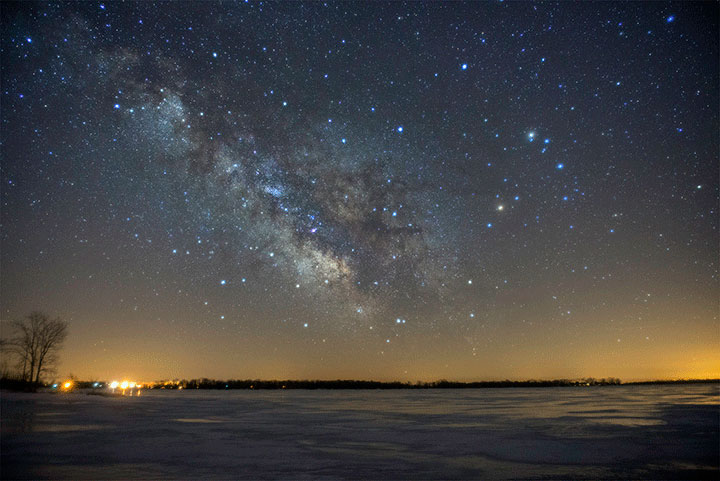When you look up at the night sky, most likely you can see only a smattering of the billions of stars in our galaxy. It’s light pollution — the unwanted upward glare of streetlights — that blocks out the magnificent spectacle that is the Milky Way.

READ MORE: Only one-third of humanity can see Milky Way due to light pollution
For many Canadians, summer is a time of camping and heading to the great outdoors, places isolated from bright city lights. Maybe you don’t want to camp, but just sit out under a sea of stars.
If you’re looking for a quick drive out of the city, use this interactive map to find the darkest locations near you. You might even find one within walking distance.
Another great resource is Dark Sky Finder, which pinpoints some of the best locations away from glaring city lights. It can simply be parking lots, an isolated park or even a pier. It’s a pretty handy tool.
If you’re looking to head a bit further out, here are just a few of the best places to see the stars this summer.
British Columbia
While not perfectly located in a dark sky location, this park allows those in and around Victoria to escape the intense city lights.
The province has a few provincial parks for people to enjoy. Porteau Cove Provincial Park, about an hour northwest of Vancouver, is a great site to soak in the night sky. You might even get the chance to catch the northern lights.
Kelowna has a considerable amount of light pollution. If you want to experience true dark skies, and enjoy a tour of the universe, head up to the Okanagan Observatory, run by the Royal Astronomical Society of Canada, Okanagan Centre. Home to a 25″ telescope, the observatory opens its doors to the public in the summer and offer a tour of the night sky.
WATCH: Vancouver councillors have bright idea to dim light pollution
Alberta
Elk Island and Beaver Hills Dark Sky Preserve
Alberta has a lot of light pollution, from Edmonton through Red Deer to Calgary. But this 300 square-kilometre dark sky preserve was established in 2006 and is part of the Elk Island National Park and the Cooking Lake-Blackfoot Provincial Recreation Area.
This park, renowned for its beauty, has some of the best views of the night sky. In 2011, the RASC designated it a dark sky preserve, ensuring light pollution doesn’t interfere with the pristine environment and view of the stars. In particular, Parks Canada says that Pyramid Island, Maligne Lake, Old Fort Point and the toe of Athabasca Glacier provide some of the darkest skies.
Saskatchewan
This park is in an extremely dark park of the province. It is also home to a dark sky preserve, once the largest (that honour now belongs to Wood Buffalo National Park that stretches across the Northwest Territories and Alberta). They have a Sleep-Under-the-Stars Party from July 22–24.
Cypress Hills Interprovincial Park
This park stretches across both Alberta and Saskatchewan. It, too, is a designated dark sky preserve. And if you’d like to look through a telescope, there is an observatory that hosts public nights for visitors (the 2016 schedule will be posted by the end of June, though it will be similar to the 2015 one). Visitors can learn about light pollution, nocturnal animals, the constellations and more. And, if the sky is clear, you can enjoy a peak through the 14″ telescope that will give you beautiful glimpses of the planets, stars and other wonders.
Manitoba
If you’re looking to escape Winnipeg’s light pollution, you can pack up and head out to St. Malo. Not only are there beaches and campgrounds, but when the sun sets, the stars come out in all their splendour.
Ontario
Torrance Barrens was the world’s first permanent dark sky reserve. It stretches across 1,900 hectacres of land and is ideally located in Muskoka, well known for camping, hiking and more. There is even a main stargazing area where amateur astronomers can set up their telescopes.
READ MORE: Saving the night—Light pollution a serious concern for human health and wildlife
If you’re in eastern Ontario, you can get away from the city lights in this perfectly located park. There are campsites and sandy beaches. The night sky is extremely dark and could be a perfect place to even spot a meteor or two.
Point Pelee, in southwestern Ontario, is another ideal location. Though not available for camping (unless you’re a group), the skies are to be envied. The park also hosts dark sky events such as Parks Day Astronomy Weekend (July 16–17) and the Perseid Meteor Celebration (Aug. 12–13).
Quebec
Mont-Mégantic Dark-Sky Reserve
The International Dark-Sky Association designated this observatory and surrounding community a dark sky reserve in 2007. The skies are extremely dark and you’ll be able to see some of the most beautiful sights the summer sky has to offer.
Atlantic Canada
Fortunately, Atlantic Canada doesn’t have to deal with the blinding light pollution that British Columbia, Quebec and Ontario has. Still, if you’re looking to camp under the best skies, you can head to Kouchibouguac National Park in New Brunswick or the Kejimkujik Dark Sky Preserve in Nova Scotia.





Comments